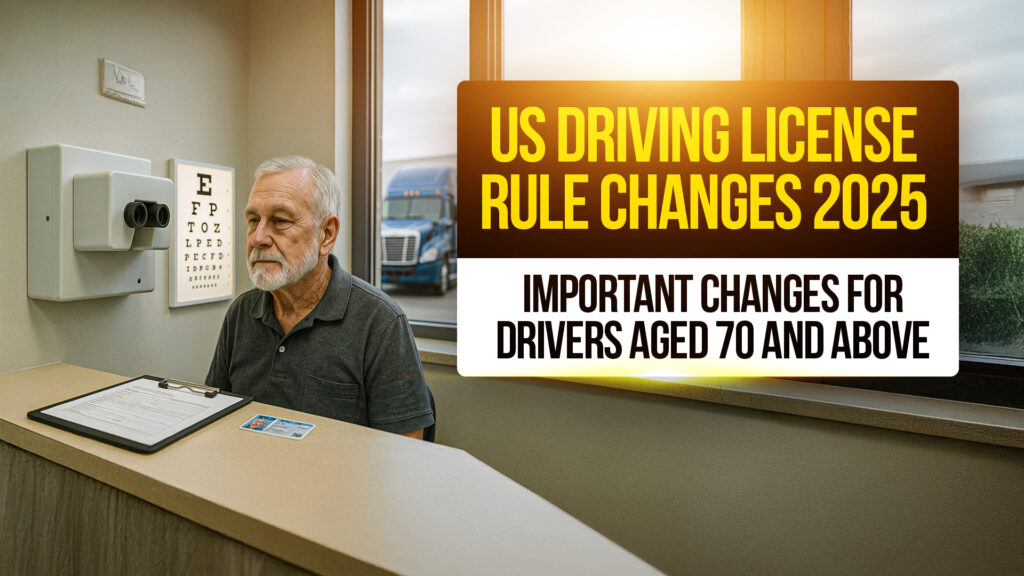
Starting September 2025, millions of older Americans will face new requirements when renewing their driver’s licenses. The U.S. Department of Transportation has announced sweeping updates aimed at improving road safety without compromising the independence of drivers aged 70 and above.
These changes come at a time when over 48 million Americans aged 65+ currently hold a driver’s license, a number expected to surpass 60 million by 2035. With aging comes safety concerns, and this new policy tries to strike a balance between freedom and public safety.
Let’s break down what’s changing, why it matters, and how seniors (and their families) can prepare.
Why the Driving Rules Are Changing for Seniors
America is getting older, and fast. As the Baby Boomer generation ages, the number of older drivers is reaching record highs. Driving is more than just transportation for many seniors; it’s a lifeline to independence.
However, natural aging can bring physical and cognitive challenges, such as:
- Slower reflexes
- Reduced vision and hearing
- Cognitive decline
- Increased risk of injury in accidents
The new rules aim to evaluate each senior driver fairly, making sure those who can safely drive still can, while flagging those who may need additional support.
Key Features of the New 2025 Senior License Rule
Instead of a one-size-fits-all approach, the 2025 rule uses a tiered system based on age. The older the driver, the more frequent and rigorous the renewal requirements become:
| Age Group | Renewal Requirements | Additional Notes |
| 70–79 | Standard renewal + vision & reflex tests | Online renewal may be allowed (varies by state) |
| 80–86 | In-person renewal every 2–4 years | Cognitive testing may apply |
| 87+ | Annual road test + medical clearance | Must prove capability yearly |
This tiered model ensures that safe drivers stay on the road, while others may face restrictions for everyone’s safety.
What Tests Will Seniors Need to Take?
Depending on age, health, and state laws, senior drivers may need to pass one or more of the following:
Vision Test
Checks for clarity, peripheral vision, and depth perception. Already required in states like Florida starting at age 80.
Reflex & Reaction Test
Measures how quickly a driver can respond to sudden hazards like a pedestrian crossing or a braking car.
Cognitive Test
Assesses memory, decision-making, and processing speed. May include traffic sign recognition or simple recall tasks.
Practical Driving Test
Required annually for those 87+ or flagged by doctors/family. Evaluates skills like merging, lane changes, and turning safely.
State-Specific Rules to Know
While the policy is federal, states can tailor certain requirements. Here’s how some are responding:
| State | Key Adjustment |
| California | In-person renewals mandatory at age 70 |
| Florida | Vision test at every renewal from age 80 |
| Texas | Annual renewals starting at age 85 |
| New York | May require doctor’s clearance from age 80 |
These adjustments help states align national standards with their own realities, like traffic patterns and healthcare access.
What If a Senior Can Still Drive but Needs Limits?
Not every older driver needs to hang up the keys entirely. Restricted licenses will be available for those who can drive with limitations. Common restrictions may include:
- Only driving during daylight
- Staying within a certain radius of home
- Avoiding highways or high-speed roads
This option allows older adults to stay mobile, just with more safeguards in place.
Alternatives to Driving for Older Adults
For those who may lose their license or choose to stop driving, several alternatives are being promoted:
- Ride-sharing services (Uber, Lyft with senior features)
- Community shuttles/paratransit
- Volunteer driver programs
- Family and friend support networks
These solutions help seniors stay connected and independent, even without a license.
Social and Economic Impact
The 2025 license rule change goes beyond just driving. It could also impact:
- Insurance premiums (based on tests or license status)
- Healthcare providers, who may be asked to evaluate driver fitness
- Auto industry, which may see more demand for senior-friendly vehicles
- Family dynamics, with adult children more involved in senior mobility
Balancing Safety and Independence
This is a sensitive topic. For many older Americans, losing a license can feel like losing a part of their identity. But ignoring the risks of impaired driving isn’t an option.
That’s why these new rules try to offer a balanced approach:
- Personalized testing
- Restricted licenses
- Mobility alternatives
It’s not about age, it’s about ability.
What to Expect Going Forward
This policy is likely just the start. As technology and demographics evolve, we may see:
- Wider use of ADAS (advanced driver assistance systems)
- Expansion of autonomous vehicle access for seniors
- More community-based transportation solutions
The success of these changes depends on how well states and families adapt, and how fairly they’re implemented.
Final Thoughts
The U.S. driving license rule changes coming in September 2025 mark a shift in how we approach aging and road safety. By focusing on fair testing, flexibility, and independence, the government is trying to protect both older drivers and everyone else on the road.
👁️ Your eyes, reflexes, and cognition matter more than your birth year.
🚗 If you or a loved one is approaching age 70, now’s the time to get informed and stay prepared.
For more updates and insights into the trucking world, stay tuned to Drivers1st.com!
